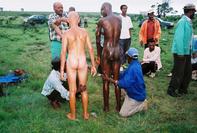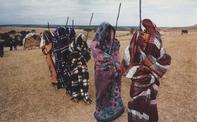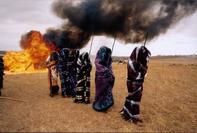
Male Initiation in South Africa
Ceremonies of South Africa
Most Xhosa initiation schools are set up in rural areas, but it has become common to find temporary lodges, erected to protect initiates from the elements, in more urban surroundings, for instance along the N2 motorway linking Cape Town to the airport.
The structures include materials obtained from dealers who specialise in supplying the inhabitants of informal urban settlements with cardboard packaging and outdated magazine posters to insulate their homes. These shelters are burnt at the end of the period of seclusion.
After days without water, and no access to cooked meals, initiates regain their strength by feasting on roasted goat meat, freshly prepared maize meal and alcohol. Today, they tend to drink commercial spirits like brandy rather than home-brewed beer.
At the end of the initiation period, young men pay homage to the ancestors before washing to remove the clay covering their bodies.
Initiates return to the camp naked. Most smear their bodies with oil or butter before wrapping themselves in new blankets, underlining the fact that they have left the past behind them.
Just before the initiation lodge is set alight, Xhosa initiates turn away without looking back, signalling that their responsibilities are to the future, and to the realities of adult life. In some cases, this includes taking care, financially and otherwise, of the family.
Assisted by young boys who look after them during their seclusion, if readily available, initiates normally chop the wood used to burn down the camp.
By
Professor Sandra Klopper




